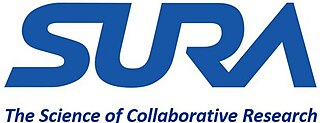
The history of the Internet has its origin in the efforts of scientists and engineers to build and interconnect computer networks. The Internet Protocol Suite, the set of rules used to communicate between networks and devices on the Internet, arose from research and development in the United States and involved international collaboration, particularly with researchers in the United Kingdom and France.

Janet is a high-speed network for the UK research and education community provided by Jisc, a not-for-profit company set up to provide computing support for education. It serves 18 million users and is the busiest National Research and Education Network in Europe by volume of data carried. Previously, Janet was a private, UK-government funded organisation, which provided the JANET computer network and related collaborative services to UK research and education.
In telecommunications, packet switching is a method of grouping data into packets that are transmitted over a digital network. Packets are made of a header and a payload. Data in the header is used by networking hardware to direct the packet to its destination, where the payload is extracted and used by an operating system, application software, or higher layer protocols. Packet switching is the primary basis for data communications in computer networks worldwide.

The Internet backbone may be defined by the principal data routes between large, strategically interconnected computer networks and core routers of the Internet. These data routes are hosted by commercial, government, academic and other high-capacity network centers, as well as the Internet exchange points and network access points, that exchange Internet traffic between the countries, continents, and across the oceans. Internet service providers, often Tier 1 networks, participate in Internet backbone traffic by privately negotiated interconnection agreements, primarily governed by the principle of settlement-free peering.
The National Science Foundation Network (NSFNET) was a program of coordinated, evolving projects sponsored by the National Science Foundation (NSF) from 1985 to 1995 to promote advanced research and education networking in the United States. The program created several nationwide backbone computer networks in support of these initiatives. Initially created to link researchers to the NSF-funded supercomputing centers, through further public funding and private industry partnerships it developed into a major part of the Internet backbone.

The Cornell University Center for Advanced Computing (CAC), housed at Frank H. T. Rhodes Hall on the campus of Cornell University, is one of five original centers in the National Science Foundation's Supercomputer Centers Program. It was formerly called the Cornell Theory Center.

The Advanced Research Projects Agency Network (ARPANET) was the first wide-area packet-switched network with distributed control and one of the first computer networks to implement the TCP/IP protocol suite. Both technologies became the technical foundation of the Internet. The ARPANET was established by the Advanced Research Projects Agency (ARPA) of the United States Department of Defense.
Fuzzball routers were the first modern routers on the Internet. They were DEC PDP-11 computers loaded with the Fuzzball software written by David L. Mills. The name "Fuzzball" was the colloquialism for Mills's routing software. The software evolved from the Distributed Computer Network (DCN) that started at the University of Maryland in 1973. It acquired the nickname sometime after it was rewritten in 1977.
The Computer Science Network (CSNET) was a computer network that began operation in 1981 in the United States. Its purpose was to extend networking benefits, for computer science departments at academic and research institutions that could not be directly connected to ARPANET, due to funding or authorization limitations. It played a significant role in spreading awareness of, and access to, national networking and was a major milestone on the path to development of the global Internet. CSNET was funded by the National Science Foundation for an initial three-year period from 1981 to 1984.

TeraGrid was an e-Science grid computing infrastructure combining resources at eleven partner sites. The project started in 2001 and operated from 2004 through 2011.

Radia Joy Perlman is an American computer programmer and network engineer. She is a major figure in assembling the networks and technology to enable what we now know as the internet. She is most famous for her invention of the Spanning Tree Protocol (STP), which is fundamental to the operation of network bridges, while working for Digital Equipment Corporation, thus earning her nickname "Mother of the Internet". Her innovations have made a huge impact on how networks self-organize and move data. She also made large contributions to many other areas of network design and standardization: for example, enabling today's link-state routing protocols, to be more robust, scalable, and easy to manage.
The following outline is provided as an overview of and topical guide to the Internet.

Glenn Ricart is a computer scientist. He was influential in the development of the Internet (ARPANET) going back to 1969 and early implementation of the TCP/IP protocol. Since then he has been active in technology and business as well as donating his time to philanthropic and educational movements.

Merit Network, Inc., is a nonprofit member-governed organization providing high-performance computer networking and related services to educational, government, health care, and nonprofit organizations, primarily in Michigan. Created in 1966, Merit operates the longest running regional computer network in the United States.
The Ohio Academic Resources Network (OARnet) is a state-funded IT organization that provides member organizations with intrastate networking, virtualization and cloud computing solutions, advanced videoconferencing, connections to regional and international research networks and the commodity Internet, colocation services and emergency web-hosting.

The Southeastern Universities Research Association, Inc. (SURA) is a non-profit association with member universities from the United States and Canada.SURA is focused on advancing science, research, and educational discovery.

Dennis M. Jennings is an Irish physicist, academic, Internet pioneer, and venture capitalist. In 1985–1986 he was responsible for three critical decisions that shaped the subsequent development of NSFNET, the network that became the Internet.

Craig Partridge is an American computer scientist, known for his contributions to the technical development of the Internet.
The Protocol Wars were a long-running debate in computer science that occurred from the 1970s to the 1990s, when engineers, organizations and nations became polarized over the issue of which communication protocol would result in the best and most robust networks. This culminated in the Internet–OSI Standards War in the 1980s and early 1990s, which was ultimately "won" by the Internet protocol suite (TCP/IP) by the mid-1990s when it became the dominant protocol through rapid adoption of the Internet.











